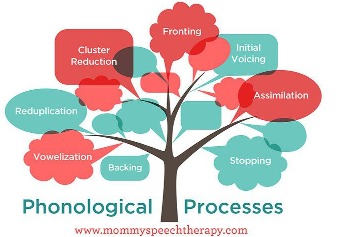
What are phonological processes
Phonological processes are the ways that young children change the sounds in words as they learn to talk. These processes are a normal part of language development and help children to produce speech sounds.
Syllable structure
Sound changes that cause sounds or syllables to be reduced, or repeated. Cluster Reduction occurs when a child simplifies a cluster of consonant sounds into a single sound or combination of sounds. ( poon for spoon,tuck for truck).
Final Consonant Deletion of a final consonant sound in a word (e.g. cuh for cup, dah for dog).
Initial Consonant sound in a word (e.g. up for cup, un for sun). If your child is using this phonological process.
weak syllable in a word (e.g. nana for banana, puter for computer).
Substitution
When one sound is substituted for another. Backing is the substitution of a sound produced in front of the mouth with a sound produced in the back of the mouth (e.g. gog for dog).
Gliding is the substitution of a glide for a liquid sound (e.g. yike for like, wug for rug).
Stopping is the substitution of a sound for a fricative sound (e.g. toap for soap, tair for chair). Your child should no longer stop their sounds after the age of 3 for words with f and s at the age of 3.5 for words with v and z.
Vowelization is the substitution of a vowel sound for a liquid l, r (e.g. bay-uh for bear).
Affrication is the substitution of an affricate (ch, j) sound for an non affricate sound (e.g. choe for shoe).
Deaffrication is the substitution of a non affricate sound (e.g. ship for chip).
Alveolarization is the substitution of an alveolar sound for a non alveolar sound (e.g. tum for thumb). Alveolarization resolves by age 5.
Depalatalization is the substitution of a non palatal sound for a palatal sound (e.g. fit for fish).
Labialization is the substitution of a labial sound for a non labial sound (e.g. mouf for mouth). Should resolve by age 6.
Assimilation
Children no longer use this process after the age of 3. Denasalization is when a nasal sound like m or n changes to a non nasal sound like b or d (e.g. dore for more).
Denasalization is when a nasal sound like m or n changes to a non nasal sound like b or d (e.g. dore for more).
Final Consonant
Devoicing is when a voiced consonant at the end of a word is substituted with a voiceless consonant (e.g. tup for tub). Expected to resolve by age 3.
Prevocalic Voicing is when a voiceless consonant in the beginning of a word is substituted with a voiced consonant (e.g. gup for cup).
when two phonemes are substituted with a different phoneme that still has similar features (e.g. foon for spoon).
Reduplication is when complete or incomplete syllable is repeated . No longer present by the age of 3.
#RaiseAgainstAutism
#PinnacleSaysItAll
#PinnacleBloomsNetwork
#1AutismTherapyCentresNetwork




